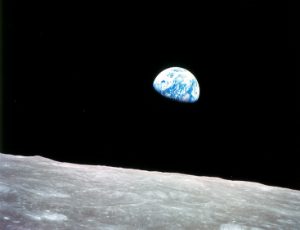So you want to be an astronaut?
You know it’s not really like Armageddon, right? (And you really hope it’s not like The Martian.) Because in real life, it’s a lot more like the movie Apollo 13.
Speaking of Apollo missions, Apollo 8 was the first time humans went to the moon and back. They didn’t get to land on the moon (that would come later, with Apollo 11), but it was a spectacular feat. It all happened in 1968, 50 years ago this month. Check out Rocket Men: The Daring Odyssey of Apollo 8 and the Astronauts Who Made Man's First Journey to the Moon to learn about the mission. While he was orbiting the Moon, Apollo 8 astronaut Bill Anders took the famous Earthrise photo.
But back to being an astronaut. It takes a lot of hard work and dedication to get there. Also, you have to know that you’re going to fail along the way. A lot. But don’t let that stop you: “If you are afraid to fail, you will probably not accomplish much in life.” Buzz Aldrin, the second man to walk on the moon, back in 1969, wrote that. That’s just one of the lessons he learned on the way to becoming an astronaut. He talks about this, and other things he learned, in his book, No Dream is Too High: Life Lessons From a Man Who Walked on the Moon.
Watching Aldrin setting foot on the moon that night in 1969 was 9-year-old Chris Hadfield. Walking home afterward, he looked up at the sky, and he knew—he just knew—that he was going to become an astronaut some day. He also knew that, as a Canadian kid growing up on a farm, this was impossible. Read how he accomplished his impossible goal in his book, An Astronaut's Guide to Life on Earth.
Also watching Aldrin that night were 5-year-old Scott Kelly and his twin brother, Mark, who both later became NASA astronauts. Unlike Chris up in Canada, however, watching the moon landing gave Scott nightmares. While Chris grew up working hard at the farm and at school, Scott was a mediocre student, and he and Mark were risk-takers. It was while he was a hard-partying, failing pre-med student that Scott was drawn to the book, The Right Stuff, about the Apollo 13 crew. The idea of doing something that difficult and risky, and surviving it, led him to become an astronaut. Read his story, and how he spent an entire year in space, in his book, Endurance: A Year in Space, A Lifetime of Discovery.
While he was an astronaut, Chris Hadfield flew two space shuttle missions. NASA doesn’t use space shuttles anymore, but you can get an idea of what it was like to fly one in The Space Shuttle Operator's Manual, by Kerry Mark Joels. If you want to think about what spacecraft could be like in the future, there’s also the U.S.S. Enterprise Owners' Workshop Manual: (NX-01, NCC-1701, NCC-1701-A to NCC-1701-E. Okay, it’s fiction, but we can dream of spaceflight, right?
Speaking of science fiction, don’t forget to check out this year’s One Book, One Chicago selection, Do Androids Dream of Electric Sheep?



Add a comment to: Read Like an Astronaut